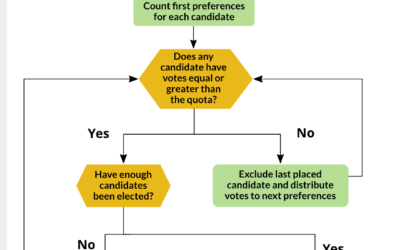Electoral Reform
The purpose of this site is to gauge interest in seeking a Citizen’s Initiated Referendum to be held on electoral reform that reflects the voters’ preferences rather than those of the political parties.
The site identifies a range of proposals for change to the way our politicians are elected, and seeks feedback on the voter’s views on the desirability of various changes to our electoral and political processes.
How to Fix America’s Two-Party Problem (NYT Jan ’25)
From How to Fix America’s Two-Party Problem Opinion By Jesse Wegman and Lee Drutman Graphics by Aileen Clarke from Jan. 14, 2025. "Imagine a Congress where politicians of different ideologies work together to pass legislation reflecting what most Americans want....
How Votes are Counted under STV
Under STV - (Single Tranferable Vote) systems each voter gets to rank candidates in order of preference. This is how votes are counted under STV. Typically you would be asked to place a number beside each candidate. To win each STV candidate needs to reach a threshold...
Six key questions.
The following set of six key questions are being asked to provide a guide as to public sentiment on a range of issues that are fundamental to the operation of a competent parliamentary democracy. The collective response will form the basis for a petition to...
Some Thoughts on Electoral Reform
Why do this? Our political class speaks and occasionally acts on the issue of electoral reform. The most recent effort, the optimistically titled the “Independent Electoral Review” conducted by the Justice Ministry at the behest of the Minister of Justice in 2022-23 came to nothing with the change in Government at the last elections. This independent review had a very restricted scope that reflected the narrow agenda of the political incumbency of the time, rather than assessing the views of the voting public. It certainly did not comprehensively address the wider process of choosing our political representation.
The present government is proposing a self-selecting four- year term. That, simply put, means that we get to elect them for three years and they get to elect themselves for one. It is hard to see how this advances democracy, but it certainly advances the interests of the incumbent political party.
It is now three decades since there was a referendum that resulted in the historical “first past the post” (FPP) electoral system being replaced with the present “mixed member proportional representation” (MMP) model. The primary reason for replacing FPP was that it led to governments that did not have majority voter support. The UK retains this system of voting, and the present UK government was elected with a “landslide majority” of electorate seats, while only obtaining 38% of the total votes cast. Worse, due to the low overall turnout the current UK government is actually only supported by the votes from 20% of the electorate.
While FPP clearly has significant deficiencies as a process for electing a government that is representative of the votes of the majority, it needs to be asked does MMP deliver a better result? Our present and recent past governments are a mix of one larger party and one or more small parties that more than 90% of the electorate did not vote for. It is likely that the great majority of voters were strongly opposed to at least some of them being a part of the government.
These small parties through their hold over coalition arrangements, also have undue influence over the policy direction of the government of the day. That MMP tends to encourage and empower extremist positions at the expense of the interests of the great majority is clearly evident in our present parliament. MMP also does not appear to have resulted in any improvement in the calibre of our elected representatives.
MMP also has not resulted in any improvement in the democratic process as there is quite evidently a growing disengagement and disillusionment among the voting public with a steady increase in the number of eligible voters not participating in the elections over the past several decades. Much of this disenchantment seems to be sourced in a frustration that politicians are more focussed on their own agendas, or those of the parties with preferential access to the political process, than they are in responding to the interests of the electorate.
This website presents a range of propositions that seek responses from eligible voters from within New Zealand to gauge the sentiment for or against a range of changes to our democratic and electoral processes.
The website also seeks to build a mailing list to enable everyone who engages with this process to join a petition to parliament for a Citizen’s Initiated Referendum on electoral reform.

Get Involved
- Vote & / or comment) on key questions.
- Subscribe to the mailing list.
- Read the blog posts & comment
- Improve local body systems
- Sign the petition. We are reviewing the best options to make this online. TBA
Example : STV Notes
STV has been around since the 1850s. Increasingly used in NZ elections since 2004.
Local Government NZ

In 2025 there are 15 local government authorities using STV for elections. Since 2004 a growing number of local councils are using STV. STV was used for District Health Board elections until these Boards were disestablished.
In the NZ private sector

Fonterra use STV for their Board of Directors and Shareholders' Council elections. DairyNZ's Board of Directors and the Victoria University's Court of Convocation also use STV. Internet NZ use STV for their elections.
International Voting

STV elections are currently held in the Republic of Ireland, Northern Ireland, Malta and parts of Australia (Senate) and the United States of America.
Our Blog
How to Fix America’s Two-Party Problem (NYT Jan ’25)
From How to Fix America’s Two-Party Problem Opinion By Jesse Wegman and Lee Drutman Graphics by Aileen Clarke from Jan. 14, 2025. "Imagine a Congress where politicians of different ideologies work together to pass legislation reflecting what most Americans want....
How Votes are Counted under STV
Under STV - (Single Tranferable Vote) systems each voter gets to rank candidates in order of preference. This is how votes are counted under STV. Typically you would be asked to place a number beside each candidate. To win each STV candidate needs to reach a threshold...
Six key questions.
The following set of six key questions are being asked to provide a guide as to public sentiment on a range of issues that are fundamental to the operation of a competent parliamentary democracy. The collective response will form the basis for a petition to...



